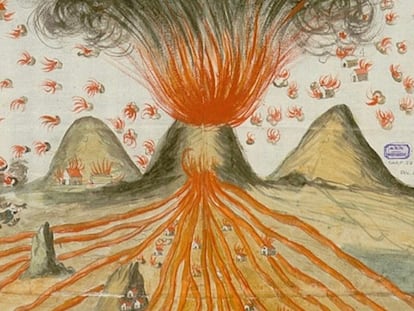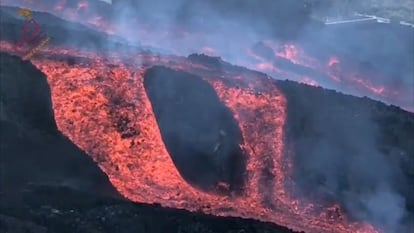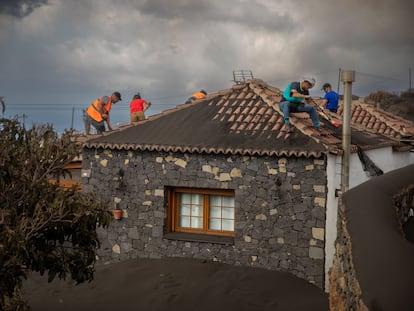La Palma volcanic eruption is now the longest seen on the island in 375 years
The new volcano, located in the Canary Islands archipelago off northwestern Africa, has been active for 67 days, exceeding the duration of Fuencaliente in 1677


“On that very same Wednesday, one hour before sunset, as the earth steamed, the first vent opened up with a great roar on the flatlands [...]; and later, immediately, within an hour, 17 more vents all the way to the foothills of said mountain, which produced a thick, flowing matter that was alight and smelled of sulfur, and it formed a river of fire that headed straight for the sea.”
This is how José Viera y Clavijo, an 18th-century priest, historian, biologist and writer from the Canary Islands, described the eruption of a volcano on the island of La Palma that took place over 66 days between late 1677 and early 1678. The historian, who was born several decades after the eruption, based his description on testimony from an eyewitness, Juan Pinto de Guisla, who saw the genesis of what would go on to become a tourist attraction in modern times: the area of Fuencaliente in the south of the island, which is part of a Spanish archipelago located off the northwestern coast of Africa.
Now, 375 years later, another as-yet-unnamed volcano on La Palma has been drawing widespread attention. The eruption inside the Cumbre Vieja natural park is into its 67th day, officially making it longer than the Fuencaliente eruption. It is necessary to go back further in time to find an eruption that lasted even longer: to 1646, when the volcano known as Martín or Tigalate spewed lava for 82 days.
One of the most widely accepted theories of the creation of the Canary Islands holds that the archipelago sits over the African Plate, which moves over the Earth’s mantle at a speed comparable to the growth of fingernails, and that around 20 million years ago this plate began drifting over a “hotspot” that injected magma and led to the creation of the first and oldest islands: Fuerteventura and Lanzarote. La Palma and El Hierro are the youngest, at 1.8 million and 1.2 million years of age, respectively. These islands are still over the hotspot, which is why they have active volcanos that are making them grow in size.
There are historical records for the last six centuries, when more than 20 eruptions were recorded in the Canary Islands. The current one, which began on September 19 of this year, is located inside the Cumbre Vieja natural park, a very active volcanic range where two out of the three most-recent eruptions in the Canaries were recorded: San Juan volcano in 1949 and Teneguía volcano in 1971.
The ongoing eruption, which is taking place on the western face of a mountain range that cuts down the middle of La Palma, will also go down in the history books as the one that caused the most damage on an island with a registered population of around 82,000. And scientists still don’t know when it will end.
So far, the lava has covered more than 1,000 hectares of land, according to the latest data provided by the European satellite program Copernicus. And local property records show that the molten rock has destroyed nearly 1,500 buildings, most of them residential. Around 7,000 evacuated people are still unable to go home, and 500 of them have required emergency housing assistance from the regional government.

The last eruption on La Palma, at Teneguía volcano, began at 4.25pm on October 26, 1971 and lasted until November 18 of that same year, making it the shortest one on record in the island. It also did not affect population centers because that volcano is located on the southern tip of the island and nearly all the lava flowed straight into the sea, expanding La Palma by around two million square meters. By contrast, an eruption that took place on the island of Lanzarote in the 18th century lasted close to six years, from 1730 to 1736, in what is now Timanfaya National Park.
The ongoing eruption at Cumbre Vieja has created two new deltas at the spots where the lava crashes down into the sea. The second one extends over five hectares and reaches 350 meters out from the coast. The first delta takes up over 43 hectares, according to data provided by Miguel Ángel Morcuende, the technical director of the team of experts monitoring the eruption, the Volcano Risk Prevention Plan of the Canary Islands (Pevolca).
With the lava flow looking stable for the moment, authorities are now worried about the rain that has been forecast for Friday, when as much as 15 milimeters of rainfall per hour is expected. This has triggered concerns about the torrents of rainwater that could form over the water-resistant lava.
Tu suscripción se está usando en otro dispositivo
¿Quieres añadir otro usuario a tu suscripción?
Si continúas leyendo en este dispositivo, no se podrá leer en el otro.
FlechaTu suscripción se está usando en otro dispositivo y solo puedes acceder a EL PAÍS desde un dispositivo a la vez.
Si quieres compartir tu cuenta, cambia tu suscripción a la modalidad Premium, así podrás añadir otro usuario. Cada uno accederá con su propia cuenta de email, lo que os permitirá personalizar vuestra experiencia en EL PAÍS.
¿Tienes una suscripción de empresa? Accede aquí para contratar más cuentas.
En el caso de no saber quién está usando tu cuenta, te recomendamos cambiar tu contraseña aquí.
Si decides continuar compartiendo tu cuenta, este mensaje se mostrará en tu dispositivo y en el de la otra persona que está usando tu cuenta de forma indefinida, afectando a tu experiencia de lectura. Puedes consultar aquí los términos y condiciones de la suscripción digital.
More information
Últimas noticias
Most viewed
- Sinaloa Cartel war is taking its toll on Los Chapitos
- Oona Chaplin: ‘I told James Cameron that I was living in a treehouse and starting a permaculture project with a friend’
- Reinhard Genzel, Nobel laureate in physics: ‘One-minute videos will never give you the truth’
- Why the price of coffee has skyrocketed: from Brazilian plantations to specialty coffee houses
- Silver prices are going crazy: This is what’s fueling the rally










































